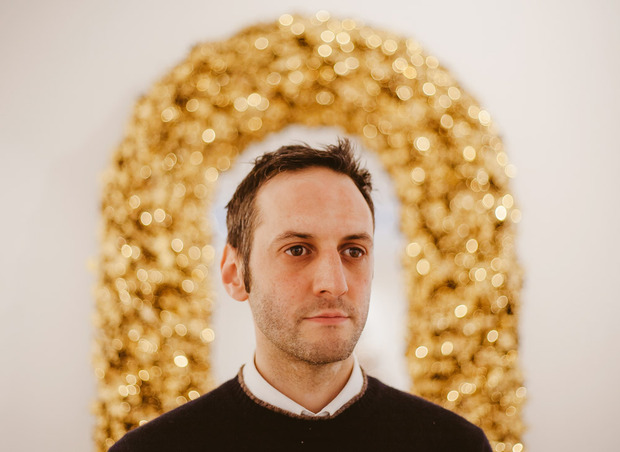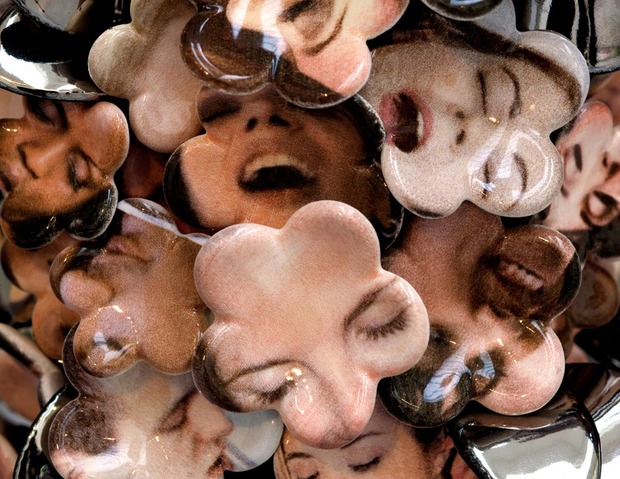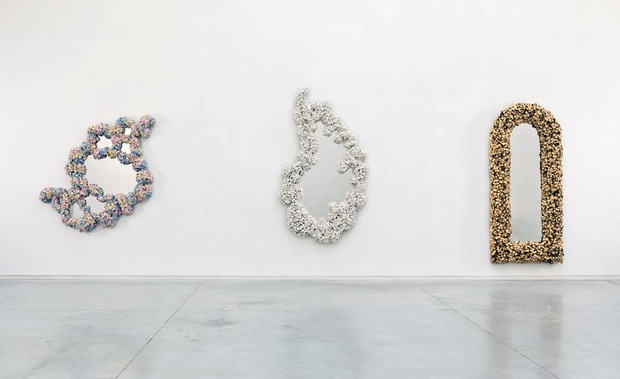Barnaby Barford’s Seven Deadly Sins
The infamous Catholic doctrine takes a look in the mirror in the UK ceramicist’s latest show
by Sabine Zetteler

Never one to shy away from making a bold statement, ceramics artist Barnaby Barford‘s new exhibition “The Seven Deadly Sins”—currently showing at London’s David Gill Gallery—addresses biblical maladies in a tellingly ironic form of ornate mirrors.
In interpreting the Catholic church’s long-condemned weaknesses and literally reflecting each one back to the viewer—in frames of deceptively sweet flowers and vibrant colors—Barford examines the possibility of beauty in the dark side and the essential truth behind human vices. Abstract details come together with each piece to create seemingly benign decorative wall hangings, which on closer inspection reveal their depth. “Wrath” is a comic book explosion in red, yellow and orange, “Pride” an immaculate golden arch and “Lust” an embarrassing splatter made up of hundreds of orgasmic faces.


Barford spent 15 months of tireless work with a team of about 30 people to create the gigantic mirrors, which are mounted in thousands of individually cast ceramic flowers, many digitally printed with unique images. Barford smartly asserts that he wasn’t going to take on a 1,500-year-old Catholic doctrine without doing his homework. Instead of aiming to present definitive conclusions on The Seven Deadly Sins, Barford hopes to reflect a line of artistic inquiry. “I like making new work when I’m trying to work something out,” he says.

The Seven Deadly Sins have been around since Pope Gregory, who helpfully itemized them to keep Christians on the right track in 600AD—so what is it about them that Barnaby needed to work out?
“It was never about religion,” he says. “I am not religious and I didn’t really want to make it into something religious. I wanted to explore what they meant today, at the beginning of the 21st century, in a more secular society, without the threat of eternal damnation. If they do matter, are there any consequences? And if there are consequences, whose beliefs are they? Is it our own conscience? Is it the law governing society?”

Barford is plainly holding up a mirror to society, but how do flowers factor into an exhibition about sin? “Flowers are the language of love,” he says. “And the deadly sins are love gone wrong. Basically, all the sins start off at the same place as the virtues—our natural impulse to love whatever pleases us. However, this love often finds itself misplaced, weakened or distorted. Pride is the love of oneself, which might be worthy to start with, but then it becomes loving nothing other than yourself. There’s something perverted about that. Sloth is where you might love something, but you don’t love it enough.”
Barford’s flowers are vehicles used to express those distortions and weaknesses, backed by the fragments of takeaway menus used in “Gluttony,” the bank notes of “Avarice,” the jazz magazines of “Lust” and the indifferent-white petals of “Sloth” (ironically, the most labor-intensive piece in the exhibition). “My initial concepts were very different even when I decided to use flowers—I thought of using more three-dimensional flowers, but as soon as I decided to use these flatter forms as a vehicle, it became clear how the body of work was going to progress.”


This conversation has taken us right to the foot of “Envy,” the one piece in the exhibition that is both utterly beautiful and unequivocally negative to look at, up close at least. It’s a clever juxtaposition that’s both pleasing to the eye and utterly unnerving, with each perfect little ivy leaf marked with a CCTV snapshot from the destructive London riots. “When you’re always looking at other people and you want what they have, you’re no longer a satisfied citizen, you’re a dissatisfied consumer,” says Barford. “So when all that breaks down, envy levels it all out: ‘If I can’t have it, then nobody can have it.’ What did the rioters do? They went shopping and they trashed everything. It wasn’t even some big conglomerates either, but the local businesses in their own boroughs.”

“Society has set us up to believe we are equal, which isn’t true,” says Barford. “This dangerous distortion is the breeding ground for envy. What’s all the more disturbing is that the notion of equality has been further perverted to imply that equal actually means identical. Individuals are feeling more and more entitled to what everyone else has, completely disregarding the fact that many people work incredibly hard to achieve their goals.”
Barford’s search for meaning among a culture obsessed with luxury and hoarding has been a running theme throughout his career. “Envy” exposes the dangerous end to which those traits can lead us, but what he aims to explore next is how we get to that point. He’s now working on a massive monument that will pay tribute to materialism based on our media-generated modern ideals.
“The Seven Deadly Sins” runs through 12 April 2013. See more images of the exhibition in our slideshow.
Images courtesy of Andy Dunn and the David Gill Gallery




















